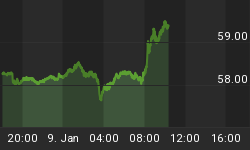Below are extracts from a commentary posted at The Deflation Threat There is an extremely good article by Sean Corrigan on the inflation/deflation issue at There is no doubt that the Fed has the power to stop deflation in its tracks should genuine deflation ever become a threat to the US financial system (at the moment it is NOT a threat, although we are anticipating that another deflation scare will be conjured up over the coming 6 months). This is because the Fed has the power to monetise an unlimited amount of debt. The question, therefore, is whether the Fed will CHOOSE to make use of all its powers in its fight to maintain the expansion of credit. We think the answer to this question is clearly provided by the actions of the Fed over the past 10 years. Or, as Mr Corrigan eloquently puts it in the aforementioned article, "...the recent history of bail-outs, emergency rate cuts, the instant provision of vast swathes of 'liquidity', and other such interventions undertaken by the central banks in the face of anything from the Mexican crisis of late-1994, through the Asian Crisis of 1997/8, the Long-Term Capital Management fiasco, the Dot.com bust, Y2k, 9/11, and so on and so forth, argues strongly that whenever the US financial system (in particular) is threatened, the floodgates are opened without further ado, even if 'rules' have to be infringed and the dictates of best practice eschewed in the process." The source of a lot of the past, present and probably future confusion surrounding the inflation/deflation issue is the linking of the words inflation and deflation to rising and falling prices. However, prices rise and fall all the time for reasons that have NOTHING to do with inflation or deflation. In particular, a drop in prices has absolutely nothing to do with deflation if it is not CAUSED by a contraction in credit. Failure to understand the true meanings of these terms typically results in the mixing up of cause and effect and leads to many logical errors.
But couldn't a large fall in asset prices bring about a contraction in credit, which, in turn, causes prices to fall throughout the economy and sets in motion a vicious circle of contracting money-supply and falling prices?
In theory, yes, but the historical record of fiat currencies shows that such an outcome is extremely unlikely. For example, if we look at what happened in the US over the past 6 years we see that each sharp decline in the stock market was followed by a sharp RISE in money-supply growth. And if we take a look at post-bubble Japan we see that massive declines in the stock and property markets over many years did NOT result in deflation even though the Japanese central bank chose not to go down the route of aggressive debt monetisation (the Japanese chose, instead, to rely almost entirely on deficit-spending by the government). So what is the basis for expecting the US to experience genuine deflation over the coming 12 months when the US central bank has clearly stated, and has demonstrated by its actions, that it is willing to monetise anything and everything should the need arise? In our opinion, there isn't one.
Deflation scares will, however, continue to happen. In fact, it seems that we must have at least one deflation scare per year in order to provide cover for the Fed's inflation agenda and to prevent most people from perceiving what's really happening in the financial world.
Gold and Interest Rates
As discussed in previous commentaries, the notion that gold dropped from $430 down to $375 due to rising interest rates only makes sense in the context that fears of higher short-term interest rates prompted a general de-leveraging within the speculating community. In other words, speculators who borrowed money to bet on the "inflation trade" were forced to cover as soon as evidence began to appear that interest rates were set to rise, even though the Fed was, and is, unlikely to act with anywhere near enough aggression to reverse the inflation tide. And the downturn was helped along by the fact that small traders -- the traders that tend to be less well capitalised and more vulnerable to being 'shaken out' of their positions when price reverses course -- had built up a substantial net-long position in COMEX gold futures.
The thing is, regardless of the reason for the drop in the gold price the drop, itself, removes some of the upward pressure on interest rates across the curve because gold is widely perceived to be a leading indicator of inflation. Therefore, the weaker gold gets the less likely it is that rising interest rates are going to become a genuine problem for the gold market and the more likely it is that the Fed will be given the freedom to continue with its pro-inflation policies for a while longer. In fact, there were some subtle signs last week that the upward pressure on short-term interest rates was already starting to abate. For example, during the week before last the yield on the 13-week T-Bill moved above the Fed Funds Rate (FFR) for the first time since early 2002, but by the end of last week it had dropped back below the FFR (refer to the chart below). March-2002 was the only other time within the past three years that the T-Bill yield moved above the FFR and on that occasion it also quickly moved back below the FFR. Furthermore, the next move by the Fed turned out to be a rate REDUCTION.
We think the next move by the Fed will be a rate hike -- most likely a 0.25% hike at the June FOMC Meeting -- but we seriously doubt that the Fed will get aggressive on the inflation-fighting front until the markets force it to do so. And with the gold price below $400 the pressure from the markets probably won't be that great.
















